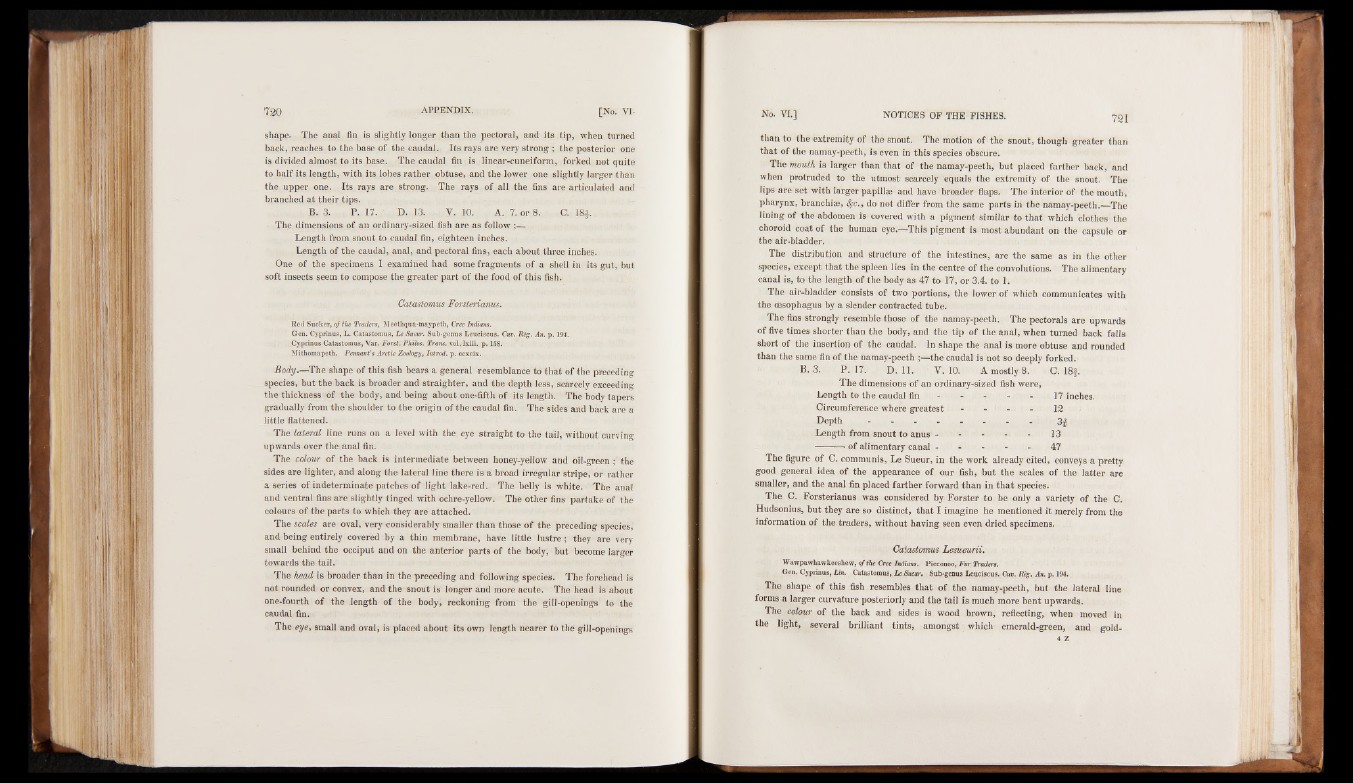
shape. The anal fin is slightly longer than the pectoral,- and its.tip, when turned
back, reaches to the base of the caudal. Its rays are very strong ; the posterior one
is divided almost to its base. The caudal fin is linear-cuneiform, forked not quite
to half its length, with its lobes rather obtuse, and the lower one slightly larger than
the upper one. Its rays are strong. The rays of all the fins are articulated and
branched at their tips.
B. 3. P. 17. D. 13. V. 10. A. 7. or 8. C. I8f ,
The dimensions of an ordinary-sized fish are as follow ;—
Length from snout to caudal fin, eighteen inches.
Length of the caudal, anal, and pectoral fins, each about three inches.
One of the specimens I examined had some fragments of a shell in its gut, but
soft insects seem to compose the greater part of the food of this fish.
Catastomus Forsterianus.
Red Sucker, o f the Traders, Meethqua-maypeth, Cree Indians.
Gen. Cyprinus, L. Catastomus, Le Sueur. Sub-genus LeUciscus. Cuv. Reg. An. p. 194.
Cyprinus Catastomus, Var. Forst, Philos. Trans, vol. Ixiii. p. 158.
Mithomapeth. Pennant’s Arctic Zoology, Introd. p. ccxcix.
Body.—The shape of this fish bears a general resemblance to that of the preceding-
species, but the back is broader and straighter, and the depth less, scarcely exceeding
the thickness of the body, and being about one-fifth of its length. The body tapers
gradually from the shoulder to the origin of the caudal fin. The sides and back are a
little flattened.
The lateral line runs on a level with the eye straight to the tail, without curving
upwards over the anal fin.
The colour of the back is intermediate between honey-yellow and oil-green ; the
sides are lighter, and along the lateral line there is a broad irregular stripe, or rather
a series of indeterminate patches of light lake-red. The belly is white. The anal
and ventral fins are slightly tinged with ochre-yellow. The other fins partake of the
colours of the parts to which they are attached.
The scales are oval, very considerably smaller than those of the preceding species,
and being entirely covered by a thin membrane, have little lustre; they are very
small behind the occiput and on the anterior parts of the body, but become larger
towards the tail.
The head is broader than in the preceding and following species. The forehead is
not rounded or convex, and the snout is longer and more acute. The head is about
one-fourth of the .length of the body, reckoning from the gill-openings to the
caudal fin.
The eye, small and oval, is placed about its own length nearer to the gill-openings
than to the extremity of the snout. The motion of the snout, though greater than
that of the namay-peeth, is even in this species obscure.
The mouth, is larger than that of the namay-peeth, but placed farther back, and
when protruded to the utmost scarcely equals the extremity of the snout. The
lips are set with larger papillae and have broader flaps. The interior of the mouth,
pharynx, branchiae, fyc., do not differ from the same parts in the namay-peeth.—The
lining of the abdomen is covered with a pigment similar to that which clothes the
choroid coat of the human eye.—This pigment is most abundant on the capsule or
the air-bladder.
The distribution and structure of the intestines, are the same as in the other
species, except that the spleen lies in the centre of the convolutions. The alimentary
canal is, to the length of the body as 47 to 17, or 3.4. to 1.
The air-bladder consists of two portions, the lower of which communicates with
the oesophagus by a slender contracted tube.
The fins strongly resemble those of the namay-peeth. The pectorals are upwards
of five times shorter than the body, and the tip of the anal, when turned back falls
short of the insertion of the caudal. In shape the anal is more obtuse and rounded
than the same fin of the namay-peeth ;—the caudal is not so deeply forked.
B. 3. P. 17. D. 11. V, 10. A mostly. 8. C. 18f.
The dimensions of an ordinary-sized fish were,
Length to the caudal fin - - - - - 17 inches.
Circumference where greatest - - - - 12
D e p t h ..................................................................3f
Length from snout to anus - - - - - 13
-------- • of alimentary canal......................................47
The figure of C. communis, Le Sueur, in the work already cited, conveys a pretty
good general idea of the appearance of our fish, but the scales of the latter are
smaller, and the anal fin placed farther forward than in that species.
The C. Forsterianus was considered by Forster to be only a variety of the C.
Hudsonius, but they are so distinct, that I imagine he mentioned it merely from the
information of the traders, without having seen even dried specimens.
Catastomus Lesueuni.
W awpawhawkeeshe w, o f the Cree Indians. Picconoo, Fur Traders.
Gen. Cyprinus, Lin. Catastomus,.L e Sueur. Sub-genus Leuciscus. Cuv. R ig . A n. p. 194.
The shape of this fish resembles that of the namay-peeth, but the lateral line
forms a larger curvature posteriorly and the tail is much more bent upwards.
The colour of the back and sides is wood brown, reflecting, when moved in
the light, several brilliant tints, amongst which emerald-green, and gold-
4 Z